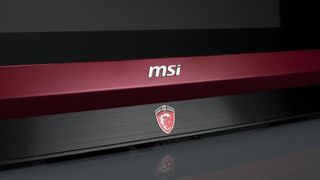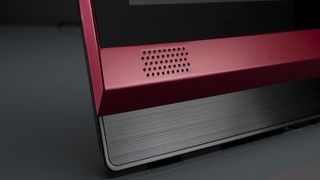Why you can trust TechRadar
The concept behind an all-in-one gaming PC is a novel one, and what MSI put out is a solid first attempt. Most gamers are only able to spend so much time adventuring in World of Warcraft or taking on teams of five in League of Legends. Otherwise, we're normal, productive people (mostly). A touchscreen allows for the ease of use of a tablet when you need to research for that report for work or browse the web, and a powerful GPU when it's time to unwind with a game of StarCraft II.
The trade-off here is that it's not quite as powerful as a standard desktop – it's more akin in speed to the latest gaming laptops we've seen from Alienware, Origin and Razer. Though, at least you'll save a few hundred dollars by choosing the all-in-one.

The AG240 costs $1,699 (about £995, AU$1,812), where a new Razer Blade Pro – also equipped with an Nvidia GTX 860M GPU – costs $2,299 (about £1,347, AU$2,451). And some components, like the RAM and solid state drives, are upgradeable when the time comes, not that the AG240 needs them now.
Indeed, almost every component fitted into MSI's adroit machine are hot off the assembly line. In the unit sent to TechRadar, it was tough to spot a flaw on paper:
Spec sheet
- CPU: 2.4GHz Intel Core i7-4700HQ (up to 3.4GHz with Turbo Boost)
- Graphics: Nvidia GeForce GTX 860M (3GB GDDR5 RAM)
- Memory: 16GB DDR3L (1,600MHz)
- Storage: 128GB Plextor PX-128M6M SSD; 1TB HGST HDD (7,200 rpm, 32MB cache)
- Optical drive: Tray-in DVD Super Multi / Blu-ray writer
- Operating system: Microsoft Windows 8.1 (64‐Bit Edition)
- Power: 150-watt AC Adapter
- Camera: 2MP webcam
- Ports: Killer E2205 10/100/1000mbps ethernet port, 3x USB 3.0, 2x USB 2.0, 3-in-1 (SD, MMC, MS) card reader, HDMI-in, HDMI-out, VGA out, mic in and mic out
- Weight: 23 pounds
- Size: 22.96 x 1.29 x 16.71 inches (WxDxH)
Day-to-day performance was more than adequate. I often could have multiple browser windows open, Spotify streaming in the background, a chat client open and my word processor sitting idly in the background without a hint of slowdown. But this level of performance should be a given in an all-in-one costing around $1,700, right?
That's why we put it to the test in last year's biggest and best games like BioShock Infinite and Metro: Last Light. While the AG240 couldn't quite trudge through Last Light on ultra settings, it made short work of the game on low settings and deftly handled intense combat scenes in the latest BioShock.

Benchmarks
These numbers are what I expected to see. As an all-in-one, the AG240 is far punchier than some gaming laptops out there – but the numbers are just shy of what I'd consider standard for a fully fledged gaming PC.
- 3DMark: Ice Storm: 101,767; Cloud Gate: 16,025; Fire Strike: 3,657
- Cinebench Graphics: 51.88 fps, CPU: 5.88 points
- PCMark 8 (Home Test): 3,080 points
- Bioshock Infinite (1080p, Ultra): 41.43 fps; (1080p, Low): 127.87 fps
- Metro: Last Light (1080p, Ultra): 11.67 fps; (1080p, Low): 67.33 fps
It's hard to believe just how snappy the latest fourth generation Intel processor is. Press the power button, and the AG240 springs to life. Another two seconds, and you're on the login screen. One more, and you'll be browsing your Steam collection before jumping into a game. Though, to be fair, I'm sure the 16GB of included RAM has something to do with it too.
Though while testing, I noticed a bit of screen tearing in some of the games I played through. It didn't happen frequently, but when artifacts popped up in the middle of a gunfight it more often than not led to me dying and restarting from the last checkpoint.
That said, the 860M is a darn good mobile GPU. It's from the latest line of Nvidia chips, and should hold up over the next year or two. Don't expect to play Crysis 4 or Assassin's Creed V on the highest settings when they make their inevitable debut in 2015, but you'll have the processing power to get mid-range results at 1080p.

Extra, extra
While most companies could have made a gaming all-in-one, I'm glad MSI was the one to follow through with it. Considering the free, six month subscription to XSplit and actually useful pack-in software, like PowerDVD and Killer Network Manager – which lets you prioritize which apps receive the most bandwidth – I think you will be too.
But MSI's penchant for detail doesn't stop at the software, and the half-dozen design improvements didn't go unnoticed. Take the included Blu-ray player, 2MP webcam or Sound Blaster speakers, for instance. Where some vendors are trying to cut corners on the optical drives in their PCs, MSI goes and crams in a blu-ray combo drive. And where some companies skimp on the speakers, MSI makes a real effort to make the most of 5-watt sound.
The only additional offerings that likely won't tickle your gaming fancy are the optional DS4100 Interceptor keyboard and DS100 gaming mouse. To put it bluntly, the keyboard just isn't up to par with the rest of the machine. The keys feel fragile and unresponsive, and there's a fair amount of flex. The mouse isn't quite as rough around the edges, but it's no SteelSeries Sensei, either.

The last feature left to test was the HDMI passthrough.
The HDMI-out port on the back of the AG240 will allow you to setup a second screen option for your all-in-one. It's a handy feature for a productivity-minded user and can be put to good use by gamers too, if they want to use a second screen for a chat window or web browser.
Nick Pino is Managing Editor, TV and AV for TechRadar's sister site, Tom's Guide. Previously, he was the Senior Editor of Home Entertainment at TechRadar, covering TVs, headphones, speakers, video games, VR and streaming devices. He's also written for GamesRadar+, Official Xbox Magazine, PC Gamer and other outlets over the last decade, and he has a degree in computer science he's not using if anyone wants it.


